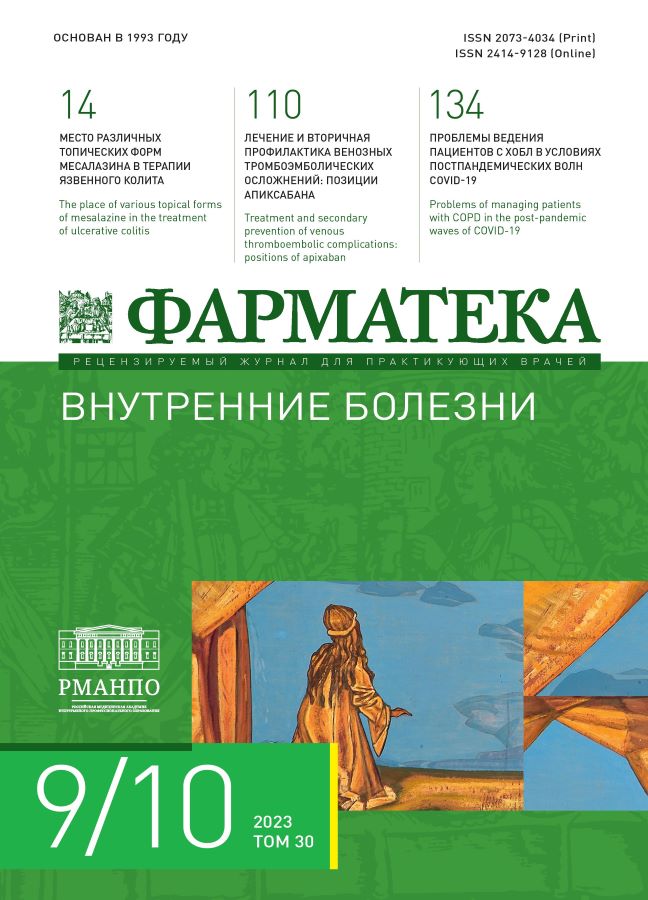Correction of urinary disorders in the early postoperative period after a trocar synthetic sling
- Authors: Danilov V.V.1, Volnykh I.Y.2, Danilov V.V.3, Danilov V.V.1
-
Affiliations:
- Pacific State Medical University
- Clinical Hospital at Vladivostok Station
- «Urinary Pathology» Center
- Issue: Vol 30, No 9/10 (2023)
- Pages: 208-212
- Section: Urology/nephrology
- Published: 25.09.2023
- URL: https://journals.eco-vector.com/2073-4034/article/view/624943
- DOI: https://doi.org/10.18565/pharmateca.2023.9-10.208-212
- ID: 624943
Cite item
Abstract
Background. After synthetic sling surgery, “de novo” urination disorders often occur, which requires correction. Pollakiuria, urgency and urge urinary incontinence, in various combinations, may require symptomatic therapy for a period of 1–2 months.
Objective. Evaluation of the effectiveness of correction of urinary disorders after trocar synthetic sling (TSS) surgery in the early postoperative period against the background of combination therapy with M-anticholinergic and alpha1-blocker.
Methods. We followed-up 140 women (mean age 55.5 years) who underwent surgical interventions using the Danilov-Volnykh method due to existing stress urinary incontinence. The urodynamic situation was monitored using a non-invasive method of in-home 2–3-day uroflowmetric monitoring. Correction of urinary disorders was carried out by prescribing combination therapy with an M-anticholinergic (Spasmex, Trospium chloride) at a dosage of 15 mg 2 times a day and the alpha1-adrenergic blocker Doxazosin, at a dosage of 1–4 mg with titration. The duration of therapy was 12 weeks.
Results. It was found that both minimum capacities and average volumes increased during therapy. Combination therapy with administration of an alpha1-blocker in this regard looks more attractive, since it will neutralize the decrease in detrusor contractility and, according to the neurophysiological model, improve the clinical picture of urinary disorders. Combination therapy prescribed for a period of up to 3 months had a positive effect.
Conclusion. The occurrence of “de novo” urinary disorders in the early postoperative period is successfully verified using uroflowmetric monitoring, and combination therapy with M-anticholinergic (Spasmex) and alpha1-blocker can successfully and quickly eliminate the resulting urinary disorders.
Full Text
About the authors
V. V. Danilov
Pacific State Medical University
Author for correspondence.
Email: vitaliy.danilov.93@internet.ru
ORCID iD: 0000-0002-7947-2873
postgraduate student at the Department of General and Clinical Pharmacology
Russian Federation, VladivostokI. Yu. Volnykh
Clinical Hospital at Vladivostok Station
Email: vitaliy.danilov.93@internet.ru
ORCID iD: 0000-0002-6151-2953
Russian Federation, Vladivostok
V. V. Danilov
«Urinary Pathology» Center
Email: vitaliy.danilov.93@internet.ru
ORCID iD: 0000-0003-2320-1406
Russian Federation, Vladivostok
V. V. Danilov
Pacific State Medical University
Email: vitaliy.danilov.93@internet.ru
ORCID iD: 0000-0001-6119-6439
Russian Federation, Vladivostok
References
- Вишневский Е.Л. и соавт. Урофлоуметрия. М.: Печатный город, 2004. 220 с.
- Данилов В.В., Вольных И.Ю., Данилов В.В., Данилов В.В. Обоснование назначения троспия хлорида в первой линии терапии при гиперактивном мочевом пузыре. Фарматека. 2023;30(1):218–22. [Danilov V.V., Volnykh I.Yu., Danilov V.V., Danilov V.V. Rationale for the use of trospium chloride in the first line of therapy for overactive bladder. Farmateka. 2023;30(1):218–22. (In Russ.)]. doi: 10.18565/pharmateca.2023.1.218-222.
- Данилов В.В., Вольных И.Ю., Данилов В.В., Данилов В.В. Изменение уровня детрузорной гиперактивности при длительном назначении М-холинолитика. Фарматека. 2023;30(4):65–8. [Danilov V.V., Volnykh I.Yu., Danilov V.V., Danilov V.V. Changes in the detrusor hyperactivity level with long-term administration of M-anticholinergic. Farmateka. 2023;30(4):65–8. (In Russ.)]. doi: 10.18565/pharmateca.2023.4.65-68.
- Вольных И.Ю. Обоснование дифференциальной тактики хирургического и консервативного лечения женщин с недержанием мочи. Автореф. канд. дисс. Владивосток, 2005. 22 с. [Volnykh I.Yu. Rationale for differential tactics of surgical and conservative treatment of women with urinary incontinence. Author’s abstract. Diss. Cand. of Med. Sciences. Vladivostok, 2005. 22 p. (In Russ.)].
- Данилов В.В., Данилов В.В. Нейроурология. Том 1. Владивосток, 2019. 280 с. [Danilov V.V., Danilov V.V. Neurourology. Vol. 1. Vladivostok, 2019. 280 p. (In Russ.)].
- Данилов В.В., Данилова Т.И., Данилов В.В. Клинико-уродинамическое подтверждение нейрофизиологической модели гиперактивного мочевого пузыря. Урология. 2010;4:15–20. [Danilov V.V., Danilova T.I., Danilov V.V. Clinical and urodynamic confirmation of the neurophysiological model of overactive bladder. Urology. 2010;4:15–20. (In Russ.)].
- Данилов В.В. Лучинский С.А., Вольных И.Ю. и др. М-холинолитики и вопросы назначения терапии при синдроме императивного мочеиспускания. Consilium Medicum. 2014;8(1):16–8. [Danilov V.V. Luchinsky S.A., Volnykh I.Yu. and others. M-anticholinergics and issues of prescribing therapy for imperative urination syndrome. Consilium Medicum. 2014;8(1):16–8. (In Russ.)].
- Данилов В.В. Диагностика и лечение комбинированных форм недержания мочи у женщин. Автореф. докт. дисс., СПб., 2006. 27 с. [Dani-lov V.V. Diagnosis and treatment of combined forms of urinary incontinence in women. Author’s abstract. Diss. Doct. of Med. Sciences. St. Petersburg, 2006. 27 p. (In Russ.)].
- Данилов В.В., Лоран О.Б. Троакарный синтетический слинг. Владивосток: Океанские Вести. 2007. 116 с. [Danilov V.V., Loran O.B. Trocar synthetic sling. Vladivostok: Okeanskie Vesti. 2007. 116 p. (In Russ.)].
- Данилов В.В., Лоран О.Б. Диагностика и лечение стрессовой и смешанной форм недержания мочи у женщин. Владивосток: Океанские вести, 2012. 223 с. [Danilov V.V., Loran O.B. Diagnosis and treatment of stress and mixed forms of urinary incontinence in women. Vladivostok: Ocean News, 2012. 223 p. (In Russ.)].
Supplementary files











